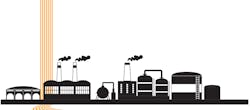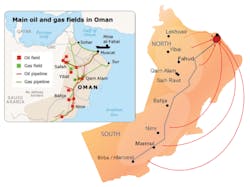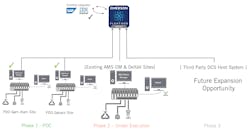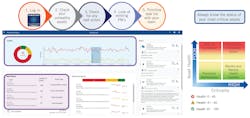Oman’s national oil company integrates asset monitoring at more than 70 sites
Keeping track of what’s going on in one or a few nearby process plants is challenging enough. Doing the same for 75 facilities across an entire nation seems like pure fantasy. However, that’s exactly what Petroleum Development of Oman (PDO) accomplished during its digitalization initiative over the past couple of years.
“We need to cover these sites because most are run by local operators during the day, but run unmanned at night. The vision for our Integrated Operations Center (IOC) was getting all out assets to collaborate, so we needed a centralized dashboard that everyone could focus on,” says Khalifa Al Aamri, senior control and automation (C&A) engineer at PDO. “The challenge was each has different controls from different OEMs, such as Emerson, Schneider Electric, Yokogawa and Honeywell. They also have different protocols, such as HART and Foundation Fieldbus and others, and all this prevented predictive maintenance because we had no dashboard.”
Al Aamri and Jagannathan Malligeswaran, engineering manager at Emerson, presented “Integrated asset management system (iAMS) dashboard” on Oct. 27 at Emerson Exchange Americas 2022 in Grapevine, Texas.
Really wide area network
These widespread operations are managed by the 75 control facilities, which are also scattered over northern and southern Oman. Their difficulties in working together are compounded by the fact that each has its own distributed control system (DCS) with hosts from different suppliers.
As part of its digitalization effort, PDO is developing an Integrated Operations Center (IOC) with a centralized instrument asset monitoring system (iAMS). This facility would connect various iAMSs from all of PDO’s sites nationwide, and would be located in its Center of Excellence (CoE) at its headquarters in the capital of Muscat. The CoE controls conventional oil operations in the north, terminal and main oil line (MOL), gas, sour gas in the north and south, power and conventional oil in the south.
In the past, PDO used traditional condition monitoring equipment with assets connected at each site, but each of the 75 sites had a separate control room. Each component also had a different template, which meant about 45,000 templates for Emerson components and hundreds of thousands for all of PDO’s other devices. The goals for the IOC are:
- Bring together different parts of PDO’s operations such as people, processes and technology in a single facility;
- Break down silos caused by geographical or organization distances for faster identification and decision-making; and
- Enhance collaboration with improved identification of opportunities across the entire production landscape, proactive issue resolution, and better decisions.
In addition, PDO’s central control room (CCR) operators are moving from field control rooms to the IOC, and assuming roles as its production system control personnel. Existing field operators are remaining in place, while many field control rooms remain as operational backups that will unmanned at night. The IOC also: monitors and controls PDO’s operations 24/7 using a revised shift pattern; supports operations with 40 engineering experts and technical authorities; and conducts management of change (MOC) activities and communications, which are expected to become more prevalent as IOC’s plans progress. The IOC also has a center of expertise that’s responsible for rotating equipment, reliability engineering, process optimization, condition monitoring, process control and SCADA/DCS support.
Starting to cooperate
Before it could get its sites to begin collaborating, PDO reports it had to overcome several other business and infrastructure challenges:
- Only localized displays of HART and Foundation Fieldbus data and diagnostics are available;
- More than 70 sites have different asset monitoring systems from various suppliers;
- Existing work processes are based on corrective/preventive maintenance and not on predictive maintenance;
- No dashboard is available with a holistic view of all valves and other devices connected to its DCSs;
- Centralized display of the health status of valves and devices is unavailable at headquarters in Muskat; and
- Need for asset health monitoring with key performance indicators (KPI) and reports via mobile devices.
To build its iAMS, PDO initiated a three-phase process, starting with facilities that already had Emerson’s DeltaV DCS. The first phase was a proof-of-concept (PoC) and pilot deployment at two less-critical sites with 4,500 devices each, which showed how their control rooms could share information and coordinate their efforts. The second phase is presently being worked on, and consists of deploying Emerson’s Plantweb Optics software at the 22 PDO sites with Emerson controls, and integrating this solution with the CoE. So far, 12 have been integrated, and the remaining 10 will be added soon. The upcoming third phase will expand this initial collaboration to all the sites with controls from different suppliers, and is expected to use MQTT networking (Figure 2).
The characteristics and solution requirements for PDO’s cooperative iAMS include:
- Centralized and system-agnostic;
- Persona-based, key performance indictor (KPI) notifications;
- Collaborative tool that supports remote monitoring and troubleshooting;
- Intuitive user-interface experience;
- Secure data transfers;
- Leverage corporate authentication; and
- Scalability and flexibility.
“This a lot like building and furnishing a new house because iAMS also needs a base to build on—and that foundation is data. In this case, users must decide what information they need, gain visibility to their sensors and instruments, and gain access to it,” explains Malligeswaran. “All digitalized applications like machine learning (ML) and business-level asset monitoring depend on this because it lets them do predictive maintenance and maintain their equipment properly.”
Adopting better optics
Malligeswaran reported that PDO settled on Plantweb Optics for its asset performance platform because gathers from the instrumentation, automation, maintenance and reliability departments at plants, and provides web-based, mobile dashboards; integration with other workflow integration software; provides persona-based content delivery; and enables connected services including augmented reality (AR). These capabilities give PDO:
- Collaboration and improved workflows by enabling communication and driving closed-loop reliability;
- Visualization and analysis with persona-based visualizations, notifications and analytical tools; and
- Connecting, collecting and contextualizing different data sources, and storing information for analysis and decision-making.
Malligeswaran adds that Plantweb Optics consists of a centralized, persona-based dashboard that gives users a unified view of monitored processes, asset health and bad actors, as well as a message feed and task list for joining forces with other team members. In addition, Plantweb Optics maintains secure connectivity because its architecture allows only outbound communications with one configurable port across all ASIs. Its enhanced connector scalability works with multiple ASIs of the same type, and it supports data sources at multiple network levels with a proxy service for securely jumping network levels (Figure 3).
Beyond collaboration, PDO expects several benefits from its asset management project and centralized dashboard at the CoE, including:
- Clear visibility of device health KPIs and their posture across entire plants;
- Preventing catastrophic failures and unplanned shutdowns;
- Assist in optimizing maintenance plans to avoid device failures to reduce or eliminate downtime;
- Determine the best times to schedule maintenance and asset overhauls;
- Shift from reactive/preventive maintenance to predictive/proactive maintenance; and
- Diagnose roots causes of degradation and recurring problems.
About the Author

Leaders relevant to this article:




